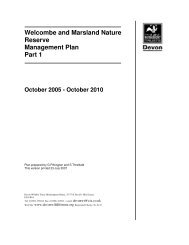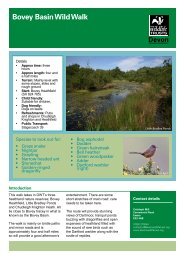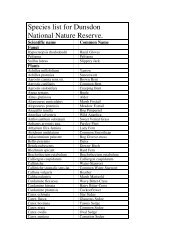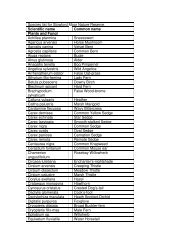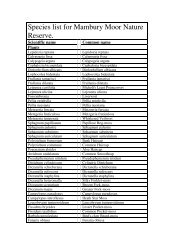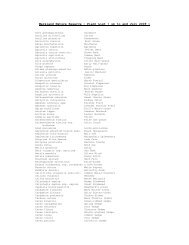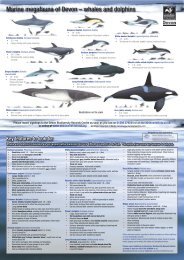James Ravilious Trail leaflet - Devon Wildlife Trust
James Ravilious Trail leaflet - Devon Wildlife Trust
James Ravilious Trail leaflet - Devon Wildlife Trust
You also want an ePaper? Increase the reach of your titles
YUMPU automatically turns print PDFs into web optimized ePapers that Google loves.
avilious<br />
Dolton<br />
as seen by<br />
<strong>James</strong> <strong>Ravilious</strong><br />
beafordarts<br />
Images by <strong>James</strong> <strong>Ravilious</strong> for the Beaford Archive © Beaford Arts
Image of <strong>James</strong> <strong>Ravilious</strong> by Alan Winn<br />
Dolton in the<br />
Beaford Archive<br />
In 1972, photographer<br />
<strong>James</strong> <strong>Ravilious</strong> took on a<br />
commission from Beaford<br />
Arts’ founding director John<br />
Lane to “show north <strong>Devon</strong><br />
people to themselves”.<br />
17 years and more than seventy<br />
thousand images later, <strong>James</strong>’<br />
Beaford Archive had become what<br />
the Royal Photographic Society<br />
called “a unique body of work,<br />
unparalleled at least in this country<br />
for its scale and quality”.<br />
After his death in 1999, <strong>James</strong>’<br />
negatives and contact sheets were<br />
placed in the strongroom at the<br />
north <strong>Devon</strong> Records Office for<br />
safekeeping. For more than a<br />
decade they remained largely<br />
inaccessible. Now, however, with<br />
the support of Leader 4 Torridge and<br />
north <strong>Devon</strong>, the 1700 images which<br />
<strong>James</strong> regarded as ‘best’ and ‘good’<br />
have been digitally scanned from his<br />
original negatives. This <strong>leaflet</strong> marks<br />
the re-emergence of these images<br />
online (www.beafordarchive.org.uk).<br />
ravilious<br />
It aims to take you past sites<br />
which inspired some of <strong>James</strong>’<br />
best-known photographs - and to<br />
show you some lesser-known<br />
images made in and around the<br />
same lanes. In the text, experts<br />
and locals reflect on what the<br />
images tell us about his routes<br />
more than thirty years later.<br />
Beaford Arts would like to thank<br />
all who have played a part - family,<br />
friends, colleagues, and the many<br />
people who have been inspired by<br />
his unique vision. Our special<br />
thanks go to the <strong>Devon</strong> <strong>Wildlife</strong><br />
<strong>Trust</strong>, whose Halsdon nature<br />
reserve makes up a key section of<br />
the walk; to <strong>Devon</strong> County Council;<br />
and to Leader 4, through which<br />
this project is part financed by the<br />
European Agricultural Fund for<br />
European Development 2007-2013:<br />
Europe investing in rural areas.<br />
1 Ashwell Farm,<br />
Ashwell, Dolton, 1977<br />
2<br />
Early morning mist<br />
on the River Torridge,<br />
Halsdon, Dolton,<br />
April 1980<br />
beafordarts
All photographs have stories<br />
associated with them. From the<br />
works of great photographers to<br />
family snapshots, an image<br />
captured on camera will evoke<br />
different reactions from different<br />
people.<br />
<strong>James</strong> <strong>Ravilious</strong> took a wealth of<br />
photographs, and in the 1970s and<br />
1980s became a familiar figure in<br />
villages across north <strong>Devon</strong> - but<br />
particularly so in the communities<br />
close to where he lived, including<br />
Dolton. Many of the resulting<br />
photographs have achieved an<br />
iconic status, black and white<br />
images of a land lost in time.<br />
From the time of his first 1972<br />
Beaford commission until his<br />
death in 1999, <strong>James</strong> made this<br />
part of <strong>Devon</strong> his home and<br />
undertook his own photography<br />
here as well as working for<br />
Beaford. This trail will take you<br />
along some of the lanes that he<br />
walked and knew well. You will<br />
see where he took the Beaford<br />
Archive photographs reproduced<br />
in this <strong>leaflet</strong>. You can simply enjoy<br />
the experience of walking through<br />
the countryside, identifying each<br />
location, but you can also use it to<br />
challenge your own perceptions;<br />
to think about each photograph<br />
and perhaps to see it with different<br />
eyes. Imagine you have stepped<br />
back 30 years; note the<br />
differences, the changes in the<br />
environment. Look at the<br />
landscape around you, look again<br />
at what a <strong>Ravilious</strong> photograph is<br />
ravilious<br />
showing, or not showing; think not<br />
just about the past, but also the<br />
future.<br />
Agriculture<br />
<strong>James</strong> <strong>Ravilious</strong> was taking<br />
photographs when north <strong>Devon</strong><br />
was in the middle of huge changes<br />
in agriculture. In his own words,<br />
his task was to compile an<br />
“endless tapestry” of <strong>Devon</strong> life; to<br />
record “the things [he] loved about<br />
<strong>Devon</strong>”. He did not aim to<br />
represent everything that was<br />
happening during what rural<br />
studies academic Martyn Warren<br />
calls a "dynamic" time for farming.<br />
"We were in the European<br />
Community, there was a lot of<br />
money in farming and there was<br />
change. But how often do you see<br />
a shiny new tractor in a <strong>Ravilious</strong><br />
image?"<br />
Beaford Arts trustee Brian<br />
Fraser Smith - who has farmed in<br />
north <strong>Devon</strong> for more than fifty<br />
years - said that the Ferguson<br />
tractor had revolutionised<br />
agriculture by the 1960s. "It<br />
changed attitudes. Youngsters<br />
who used to mess around with<br />
cows were now messing around<br />
with tractors. The rapidity of<br />
mechanisation changed farming<br />
completely."<br />
Brian added: "Farms had been<br />
getting bigger in order for people<br />
to make a living. The younger<br />
generation didn't want to live at<br />
4<br />
3<br />
Early morning at<br />
Halsdon, Dolton,<br />
February 1987<br />
Sawing-up timber,<br />
Halsdon, Dolton,<br />
August 1978<br />
beafordarts
the levels of the past. TVs and cars<br />
had been coming in and intensive<br />
farming was taking off."<br />
You may not find a new tractor,<br />
or scenes from modern farming life<br />
in these images, but a careful look<br />
still reveals signs of change, one<br />
of which is the use of metal gates<br />
which became commonplace in<br />
the 1950s and 60s. They often<br />
appear in these photographs;<br />
there is even a glimpse of one in<br />
7 Snowy lane with Heron, West<br />
Lane, Dolton, February 1978, an<br />
otherwise almost frozen-in-time<br />
image.<br />
Environment<br />
Do you see many differences in<br />
the natural environment when you<br />
look around you now? Some things<br />
appear to have changed little.<br />
There is huge delight in spotting<br />
the same sheds in 11 Ducks<br />
beside a frozen stream, Millhams,<br />
Dolton, April 1985, albeit more run<br />
down and overgrown. It's<br />
reassuring to sense the timeless<br />
quality that still pervades these<br />
valleys and lanes around Dolton.<br />
But take another, closer, look.<br />
<strong>Devon</strong> is famous for its hedges<br />
and deep lanes, pathways that<br />
have traversed history, creating a<br />
funnelled oasis of timelessness -<br />
an atmosphere perfectly caught in<br />
15 Lost sheep in a lane, Millhams,<br />
Dolton, June 1982. Martyn Warren<br />
notes there is a "permanence"<br />
ravilious<br />
about these lanes; "rock in<br />
abundance" was used to build up<br />
the sides, the tracks were worn<br />
down over the years by horses'<br />
hooves and cart wheels. At the<br />
same time green, rampant growth<br />
flourished, the product of a damp<br />
climate. But this time-worn solidity,<br />
the heaviness sensed in this<br />
image, is paralleled by a constant<br />
fluidity.<br />
North <strong>Devon</strong> Biosphere Reserve<br />
manager Andy Bell explains how<br />
over the years, verges and banks<br />
have been eroded by much larger,<br />
modern vehicles, creating a<br />
channel effect in the lanes. These<br />
roads and pathways have always<br />
provided a way for water to get to<br />
rivers, but in the past much was<br />
absorbed by hedges. Now<br />
however, without verges "water<br />
comes down like a torrent,<br />
sweeping sediments into our<br />
rivers". Delicate shifts through<br />
history in one lane will have an<br />
impact on the wider environment.<br />
5 Beside the River<br />
Torridge, Dolton Mill,<br />
April 1980<br />
6<br />
Jean Pickard leading<br />
her flock, Woolridge,<br />
Dolton, September 1975<br />
beafordarts
<strong>Ravilious</strong>' landscape is now in<br />
the heart of an internationally<br />
recognised Biosphere Reserve<br />
stretching across more than 1350<br />
square miles - one of fewer than<br />
600 such places on the planet.<br />
North <strong>Devon</strong> is an area of land<br />
identified for its unique variety of<br />
moorland, valleys, rivers, culm<br />
grasslands, estuaries, dunes and<br />
marine life. The strength of this<br />
diverse landscape is its ability to<br />
withstand change, each element<br />
linked together to play an<br />
important role in sustaining a<br />
balanced, productive and lifesupporting<br />
environment.<br />
Andy looks at these photographs<br />
and sees "a remarkable lack of<br />
change" but he also knows that<br />
environmental shifts, caused by<br />
pollution or climate change, are<br />
taking place. He knows that the<br />
River Torridge at the time of<br />
5 Beside the River Torridge,<br />
Dolton Mill, April 1980, was "a very<br />
polluted river, brown with<br />
discolouration". He knows that the<br />
tree species seen in 13 Archie<br />
Parkhouse and his dog Sally,<br />
Millhams, Dolton, April 1982, will<br />
be changing, the beech with its<br />
shallow, drought-vulnerable roots<br />
being the first to go. These<br />
changes may not be apparent<br />
when you look at the photographs,<br />
or the present day landscape, and<br />
some may take hundreds of years<br />
to reveal themselves, but they are<br />
taking place nonetheless. We can<br />
quickly swap a corrugated iron<br />
ravilious<br />
roof for slate tiles; we can<br />
demolish buildings or hedges in<br />
days. These are quick and easy-tospot<br />
changes, but it will be many<br />
years before the trees that<br />
populate our woods and<br />
hedgerows adapt to shifts in the<br />
climate.<br />
Andy said: "It's not about<br />
avoiding change but managing it.<br />
You need to future proof an area<br />
and this is about keeping variety<br />
and the way it hangs together. So<br />
we still need to make sure we<br />
keep our woodlands, even if the<br />
type of tree that grows in them<br />
changes. In future we may have to<br />
grow different crops, but for the<br />
past 40 years we've been adapting<br />
and the older farming communities<br />
have the skills to do this, we can<br />
use that knowledge to adapt to the<br />
future."<br />
This diverse landscape, with its<br />
challenging farming conditions,<br />
has perhaps forced a slower pace<br />
of change in north <strong>Devon</strong> when<br />
compared to the wide open arable<br />
landscape in some other parts of<br />
England. But that slowness, a pace<br />
that is reflected in the images of<br />
<strong>Ravilious</strong>, perhaps makes this<br />
environment better able to adapt<br />
to the demands of the future.<br />
7 Snowy lane with<br />
Heron, West Lane,<br />
Dolton, February 1978<br />
8<br />
George Ayre and Jo<br />
Curzon spraying a<br />
shorn lamb, Addisford,<br />
Dolton, July 1985<br />
beafordarts
To Beaford<br />
2<br />
1<br />
P<br />
Ashwell Car Park<br />
(North Entrance)<br />
3<br />
River Torridge<br />
The suggested circular route<br />
starts from point 1 at Ashwell<br />
and follows the numbered<br />
locations sequentially. The<br />
walk is approximately 9km<br />
covering riverside meadows,<br />
woodland and lanes and<br />
incorporating <strong>Devon</strong> <strong>Wildlife</strong><br />
<strong>Trust</strong>’s white route through<br />
the nature reserve.<br />
The marked route covers<br />
publicly accessible land.<br />
Please respect private<br />
property and do not stray<br />
from this path.<br />
4<br />
16<br />
West Lane<br />
To Dolton<br />
7<br />
8<br />
6<br />
P<br />
Quarry Car Park<br />
(South Entrance)<br />
5<br />
9<br />
10<br />
11<br />
12<br />
13<br />
15<br />
14<br />
To Langham
People<br />
<strong>Ravilious</strong> recorded a human<br />
element to his landscapes,<br />
showing how people had an<br />
impact on the environment around<br />
them. Andy Bell notes the<br />
frequency of women portrayed in<br />
farming this landscape. One of<br />
these familiar faces around Dolton<br />
and Beaford was Jean Pickard.<br />
Simon Berry, from <strong>Devon</strong> <strong>Wildlife</strong><br />
<strong>Trust</strong>, remembers as a boy on his<br />
way to school being held up by the<br />
"effervescent" Jean with her flock.<br />
The photograph, 6 Jean Pickard<br />
leading her flock, Woolridge,<br />
Dolton, September 1975, brings<br />
back fond memories of that time,<br />
but also of the present when<br />
Simon leads his own special breed<br />
cattle along the same lane.<br />
Simon also remembers Archie<br />
Parkhouse as "the wise man of<br />
Dolton". "He died when I was very<br />
young. He was a big man and I<br />
was afraid of him, you'd know<br />
when he was around because you<br />
could smell his baccy. He loved the<br />
woods, and could tell the weather<br />
by the woods. He knew by the<br />
leaves if it was going to rain."<br />
Brian Fraser Smith knew similar<br />
characters in other villages.<br />
"Archie Parkhouse was of a breed<br />
that was vanishing by the 1970s.<br />
There was a huge change going<br />
on at that time, a change that<br />
broke up a lot of traditions, an<br />
influx of people coming into<br />
farming who were not traditional."<br />
ravilious<br />
Brian also speaks of frugality, a<br />
pride in the older generation of<br />
“making do”, and a “waste not,<br />
want not” attitude. But at the same<br />
time, the younger generations<br />
were moving around more,<br />
communities were breaking up<br />
and evolving. "We had been fairly<br />
content, but by the end of the 50s<br />
and 60s, we could see another<br />
world out there, within reach."<br />
For the casual viewer, the<br />
romantic nostalgia of some of the<br />
images can hide the underlying<br />
hardship. Martyn Warren points<br />
out that "there is a danger of<br />
looking at a <strong>Ravilious</strong> picture and<br />
investing it with a romantic view of<br />
what's lost. You smile at someone<br />
putting a bag on their head in<br />
12 Archie Parkhouse, Millhams,<br />
Dolton, April 1975, but he’s<br />
traipsing around in the mud and<br />
cold. What would have been his<br />
reaction if you'd offered him a nice<br />
shed with straw in it for lambing?"<br />
10 Millhams cottages with<br />
crossed geese, Millhams, Dolton,<br />
June 1975, is another bucolic<br />
image, the country cottage with a<br />
smallholding; but a closer look<br />
reveals the antithesis of a quaint<br />
image. "It's a collection of old<br />
gates and binder twine, crumbling<br />
cottages and a rough, probably<br />
very unproductive, pasture." said<br />
Martyn.<br />
9 Archie Parkhouse<br />
and Ivor Brock moving<br />
a sick ram, Addisford,<br />
Dolton, March 1976<br />
10<br />
Millhams cottages<br />
with crossed geese,<br />
Millhams, Dolton,<br />
June 1975<br />
beafordarts
In 8 George Ayre and Jo<br />
Curzon spraying a shorn lamb,<br />
Addisford, Dolton, July 1985, we<br />
see once more the tell-tale signs<br />
of modernisation reflected in the<br />
use of mechanical clippers and the<br />
fertiliser bag. It is a beautiful<br />
image, sheep shearing in the sundappled<br />
shade of a tree, but to<br />
some it has different undertones.<br />
Brian said "He's having to treat the<br />
lamb, something has gone wrong<br />
somewhere. To some of those<br />
farming at the time, this would<br />
have seemed old fashioned." A<br />
contemporary farmer commented<br />
that in the present day he would<br />
not carry out such work under the<br />
trees, in the damp. "There's<br />
something lovely about it, but for<br />
some it might also be a little<br />
disturbing."<br />
Likewise, the sheep in 9 Archie<br />
Parkhouse and Ivor Brock moving<br />
a sick ram, Addisford, Dolton,<br />
March 1976, might be quite unwell.<br />
Is this the best way to transport<br />
such an animal? These days it<br />
would be more likely to be carried<br />
safely in a quad trailer. An almost<br />
comic image suddenly takes on a<br />
different feeling. But despite this<br />
harsh rawness, it's an image that,<br />
to some, reflects a community<br />
spirit, farmers getting together to<br />
help each other out. "Farming was<br />
very labour intensive, so people<br />
helped each other, everybody<br />
interacted", said Brian.<br />
Look at a <strong>Ravilious</strong> picture and<br />
try and put yourself in the image.<br />
ravilious<br />
What did it really feel like for these<br />
people? A bag was to hand, so<br />
Archie used it to shelter from the<br />
snow, but what would he have said<br />
if he'd been offered a better hat?<br />
Would these people have rejected<br />
or embraced change?<br />
Martyn said: "Our instinctive<br />
reaction to these powerful images<br />
is regret for times past, and a<br />
desire to preserve. Our second<br />
thought, though, should be for the<br />
people depicted and, particularly,<br />
their successors. We ourselves<br />
value the comforts that have<br />
brought about change in society.<br />
Do those in north <strong>Devon</strong> villages<br />
value them any less, and would<br />
they want to turn the clock back<br />
for the sake of a simpler, more<br />
picturesque lifestyle?”<br />
Art? Documentary?<br />
or both?<br />
So how should we view these<br />
pictures?<br />
Martyn sums up: "I think he was<br />
an artist first and foremost, and<br />
without the great aesthetic and<br />
technical qualities he brought to<br />
his photographs we would not be<br />
so interested in them today. But<br />
what gave focus to his work was a<br />
determination to preserve an<br />
image of something he saw as<br />
dying under the influence of<br />
change. He was capturing, before<br />
it was lost, something precious.”<br />
12<br />
11 Ducks beside a<br />
frozen stream,<br />
Millhams, Dolton,<br />
April 1985<br />
Archie Parkhouse,<br />
Millhams, Dolton,<br />
April 1975<br />
beafordarts
"<strong>James</strong> saw things were<br />
shifting," added Brian, "and it was<br />
fortunate that he caught that<br />
change, the tail end of a way of<br />
life."<br />
It's the old Foden vehicle that<br />
catches Brian's eye in 4 Sawingup<br />
timber, Halsdon, Dolton, August<br />
1978. A relic from the past. "It must<br />
have been very dry to get that<br />
Foden down there," he said, "and<br />
Health and Safety people would<br />
throw a fit, they have no protective<br />
gear! <strong>James</strong> was certainly<br />
recording things that were<br />
changing."<br />
Simon Berry feels above all else<br />
<strong>James</strong> was on a never-ending<br />
quest to 'capture the moment'.<br />
<strong>James</strong> was taking photographs<br />
when Simon was growing up in<br />
Dolton, so Simon was very familiar<br />
with the man who was "always<br />
around with his camera". <strong>James</strong><br />
was viewed by some locals as "an<br />
artistic type", always very polite,<br />
very unassuming, but also keeping<br />
his distance, never getting directly<br />
involved. The essence, some might<br />
say, of the documentary<br />
photographer.<br />
"He was very conscientious, he<br />
never took a photo for the sake of<br />
it, the conditions had to be right. I<br />
know the trouble he'd go to the<br />
make sure the picture was right."<br />
Simon himself appears in several<br />
of <strong>James</strong>' photos, but when he<br />
looks at them now, it's not himself<br />
or a memory from the past that<br />
comes to mind. "I don't think about<br />
ravilious<br />
the images. I think of <strong>James</strong>. I<br />
think <strong>James</strong> wasn't so interested<br />
in what was happening to the<br />
sheep, or the fact it's a good bit of<br />
hedgelaying, he's only interested<br />
in the moment. That's what these<br />
photos mean to me."<br />
So it's not a portrait of two<br />
children in 5 Beside the River<br />
Torridge, Dolton Mill, April 1980,<br />
but a study in light that Simon<br />
sees. He notices the line of light<br />
edging the mill and the tree, the<br />
mist in the distance, the way the<br />
boy near the water's edge leads<br />
your eye upstream towards that<br />
mist. "I don't know if <strong>James</strong> even<br />
saw the children, but he did see<br />
the light and the the shadows".<br />
Again in 1 Ashwell Farm,<br />
Ashwell, Dolton, 1977, we can see<br />
<strong>Ravilious</strong>' love of the light, the use<br />
of black and white photography<br />
enhancing the atmospheric haze<br />
over the distant hills. And in<br />
2 Early morning mist on the River<br />
Torridge, Halsdon, Dolton, April<br />
1980, the stark uprights of the<br />
foreground trees show in contrast<br />
to the sunlit mists rising up from<br />
the river. Simon thought <strong>James</strong><br />
seemed to prefer photographing<br />
the lower woodland and river<br />
areas, rather than the higher<br />
viewpoints of Halsdon Reserve.<br />
Maybe it was this quality of light<br />
and atmosphere that appealed to<br />
the artist's eye.<br />
13<br />
Archie Parkhouse<br />
and his dog Sally,<br />
Millhams, Dolton,<br />
April 1982<br />
14<br />
Hedger’s lunchbreak:<br />
Stephen Squire,<br />
Lower Langham,<br />
Dolton, February 1980<br />
beafordarts
Final Thoughts<br />
So these images, just a small<br />
handful of the many thousands<br />
taken by <strong>James</strong> <strong>Ravilious</strong>, can be<br />
viewed in many ways.<br />
What do you see when you look<br />
at 14 Hedger’s lunch-break:<br />
Stephen Squire, Lower Langham,<br />
Dolton, February 1980? Do you<br />
think of Stephen and wonder if he<br />
still works in this field? This is a<br />
perfectly laid <strong>Devon</strong> hedge bank,<br />
worked on by a master craftsman.<br />
Is it still the same today?<br />
"This shows a real professional<br />
who knows what he's doing," said<br />
Brian Fraser Smith. "The sides dug<br />
up to strengthen the bank, the<br />
hedge on top laid very effectively<br />
to stop animals going over and<br />
grass turves have been cut and<br />
put in underneath. This was a skill<br />
you learned."<br />
Or do look at this image through<br />
the artist's eye, as a series of<br />
shapes, a perfect study of form,<br />
light and shade?<br />
Or perhaps it is the mood of the<br />
image that overwhelms, creating a<br />
very personal response.<br />
"It doesn't really matter how<br />
people see these images - it's<br />
what they mean to them that<br />
matters," said Simon Berry.<br />
Another endless moment intended,<br />
in the words of <strong>James</strong> <strong>Ravilious</strong>’s<br />
original commission, “to show<br />
north <strong>Devon</strong> people to<br />
themselves”.<br />
ravilious<br />
15 Lost sheep in a<br />
lane, Millhams, Dolton,<br />
June 1982<br />
16<br />
Huntsman<br />
calling the hounds,<br />
Halsdon, Dolton<br />
December 1976<br />
beafordarts
How to Find Halsdon Nature Reserve<br />
By public transport<br />
There is a bus service to the nearby village of Dolton. For up to<br />
date bus and rail timetable information call 0871 2002233 (open<br />
7am-9pm daily except Christmas day).<br />
By car<br />
Follow the A3124 north past Winkleigh, turn off to Dolton<br />
opposite the petrol station at Dolton Beacon. In Dolton, turn<br />
right up Fore Street, passing the Royal Oak pub on the left.<br />
Continue out of the village down West Lane until you reach a<br />
crossroads. Turn right (signposted Halsdon), either park in the<br />
lay-by on the left (grid ref SS 560 116 please park here for<br />
disabled access) or continue for about 1 mile until you reach a<br />
track on the left with a wide entrance and a DWT sign. Follow<br />
the track to the car park (grid ref SS 557 133).<br />
From Torrington: follow the A3124, past Beaford take the minor<br />
road towards Dolton taking the next right (signposted Halsdon).<br />
Follow this road for about 1.5 miles until reaching the track on<br />
the right with a DWT sign at the entrance. Follow this track to<br />
the car park (grid ref SS 557 133).<br />
A388<br />
To Holsworthy<br />
To Bideford<br />
Great<br />
Torrington<br />
A386<br />
Halsdon<br />
Nature<br />
Reserve<br />
A3124<br />
A377<br />
Chumleigh<br />
Winkleigh<br />
The European Agricultural Fund for Rural Development: Europe investing in rural areas<br />
Contacting Beaford Arts<br />
Beaford Arts, Greenwarren House, Beaford, Winkleigh EX19 8LU<br />
Tel: 01805 603201 Email: info@beaford-arts.org.uk<br />
www.beaford-arts.org.uk<br />
Contacting <strong>Devon</strong> <strong>Wildlife</strong> <strong>Trust</strong> (DWT)<br />
Tel: 01392 279244 Email: contactus@devonwildlifetrust.org<br />
www.devonwildlifetrust.org<br />
Enjoying your visit – Information and<br />
Health and Safety Points<br />
To get the most from your visit without<br />
harming the wildlife, please remember:<br />
Respect wildlife<br />
Don’t pick flowers or disturb nesting<br />
birds! If you see anything particularly<br />
exciting during your visit please note it in<br />
the record book in the nature reserve<br />
wildlife hide.<br />
Riding & cycling<br />
Horse riding and cycling are not<br />
permitted on Halsdon nature reserve<br />
Gates<br />
Leave all gates as you find them.<br />
Dogs<br />
Dogs are welcome in the woodland areas<br />
of the nature reserve but are not<br />
permitted in the riverside meadows at<br />
any time. Keep your dog under close<br />
control at all times. Please clean up after<br />
your dog.<br />
Getting around<br />
The terrain is uneven with some steep<br />
and muddy paths. Wear sensible<br />
clothing and make sure you have suitable<br />
footwear.<br />
Access to riverside meadows (Locations<br />
2 and 4)<br />
To help wildlife we ask that you respect<br />
the following restrictions:<br />
Summer months: access is by permit<br />
only. Permits are available from DWT.<br />
Winter months: no more than two people<br />
walking together.<br />
Dogs are not permitted in the riverside<br />
meadows at any time.<br />
Take care<br />
Visitors are reminded that all areas of the<br />
countryside contain inherent, natural<br />
hazards so we ask you to take suitable<br />
and sufficient precautions to avoid injury<br />
or harm.<br />
Text by Catherine Jones<br />
Designed by The Olden Group<br />
Tel: 01271 375393<br />
Beaford Arts is a registered charity. Registered<br />
in England and Wales, charity number 279784.<br />
Company number 1485291.<br />
Leaflet available in larger print





